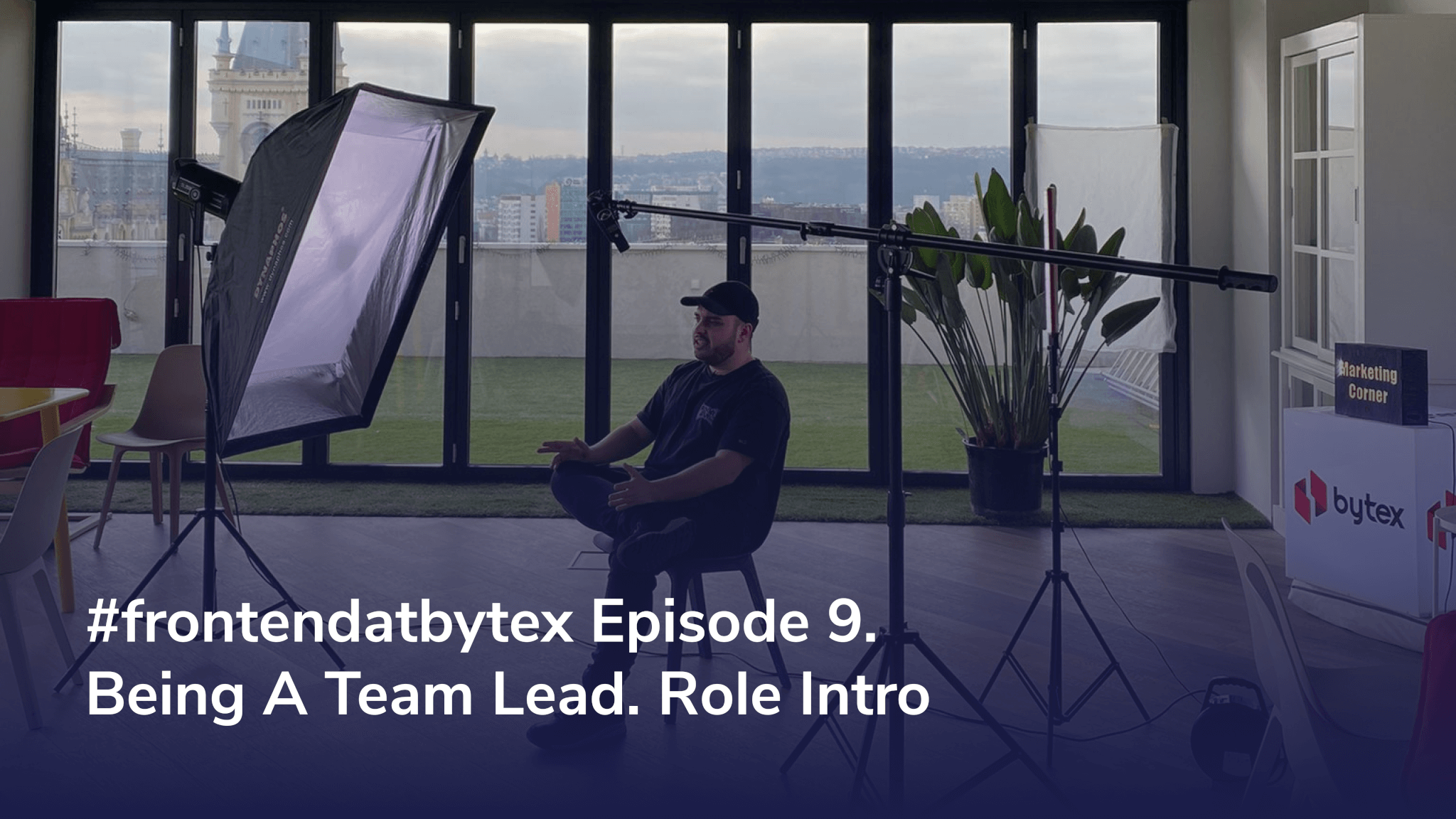You might become a good team lead, and here’s what to look for.
If you are just getting started with IT, and it is a brand new world filled with different opportunities, here is a content series that you might find useful to get a better grasp of frontend in general.
In today’s episode, our colleague Alex Cojocariu speaks about his Team Lead position and what it entails. Video and script below:
Hi there, glad you could join us once more for another episode of Frontend at Bytex. We’re back again with a topic that hits close to home for me and that is, the Team Lead Role.
Responsibilities And Challenges
As a team lead, my role involves overseeing the progress of software engineers, UX and QA specialists in order to ensure timely delivery of projects that meet quality standards. I prioritize fostering a positive and collaborative work environment that promotes learning, growth and innovation.
One of my main responsibilities as a team lead is to provide clear communication and expectations to my team all while making sure everyone understands their individual roles and how their contributions fit into the bigger picture. Anyone in this position should strive to lead by example, setting the standard for professionalism, work ethic and attention to detail.
Another important aspect of my role is to provide regular feedback and coaching to team members, including performance reviews, mentoring and training opportunities. I encourage open and honest communication, addressing concerns and conflicts as soon as they arise.
The daily challenges I face include managing competing priorities, keeping the team motivated and engaged, and adapting to changing requirements or tight deadlines. I rely on effective time management, delegation and collaboration to overcome these challenges.
Team Leading And Delegative Management
In terms of similarities between the team lead role and delegative management, both require strong communication skills and the ability to trust and empower team members. However, as a team lead, I am still ultimately responsible for the success of the project and must make final decisions when necessary. Delegative management, on the other hand, involves giving team members more autonomy and decision-making power. So there’s a fine balance between the two and it might also vary depending on the willingness of your team members to be involved in certain decision making processes.
Team Lead Versus Manager
I used the word ‘management’ a few seconds ago and this begs the question: are there any noteworthy differences between a manager and a team lead ?
While managers oversee a broader range of functions within a company and may not have direct oversight over a specific team or project, team leads are typically focused on managing a specific group of individuals and ensuring their success on a particular project or set of tasks. Additionally, while managers may focus more on administrative tasks like budgeting and hiring, team leads focus more on operational tasks like task delegation, team development, and project management.
Good Team Leads Versus Great Team Leads
While both good and great team leads share many of the same qualities, there are a few key differences that set the truly exceptional ones apart.
One of the main differences is their ability to inspire and motivate their team. A great team lead understands that motivation comes from more than just compensation and incentives – it comes from a sense of purpose, belonging, and accomplishment. They are able to create a positive work environment that fosters creativity, innovation and growth, and are skilled at recognizing and celebrating their team’s successes.
Another important trait of a great team lead is their ability to communicate effectively with all members of the team. They are able to listen actively, provide constructive feedback, and adjust their communication style to fit the needs and preferences of each team member. They are transparent and honest in their communication, setting clear expectations and providing regular updates on the status of the project.
A great team lead also prioritizes continuous learning and development, both for themselves and for their team. They are open to feedback and actively seek out opportunities for growth and improvement, and encourage their team to do the same. They understand that the world of software development is constantly evolving, and that staying up to date on the latest tools, techniques and trends is essential for success.
Finally, a great team lead understands the importance of empathy and emotional intelligence in their role. They are able to recognize and respond to the needs and concerns of their team members, and create a culture of respect, trust, and support. They are able to balance the needs of the team with the needs of the project, and are skilled at navigating conflicts and resolving issues in a positive and constructive manner.
Some of you might have started thinking that there are some similarities between the team lead and the tech lead roles, and you’d be right: the border between them might get fuzzy from time to time. Companies might choose to merge those roles or keep them separated, I personally believe both approaches are just as viable. Nonetheless, I do encourage you to check out our previous episode in which our awesome colleague Alex Raescu went into the ins and outs of the tech lead role.
Let’s end with a quick but valuable summary: great team leads stand out for their ability to inspire and motivate their team, communicate effectively, prioritize continuous learning and development, and demonstrate empathy and emotional intelligence. These traits are essential for building high-performing, happy, and successful teams.
Thank you for joining us. I’ve been Alex and this concludes our Frontend at Bytex miniseries. Stay tuned for whatever creative endeavor we’ll explore next. Bye bye!’
If you are looking to become a team lead, you think it could be a right fit for you and you’re looking to explore this further, you can watch the entire frontend series on YouTube.


